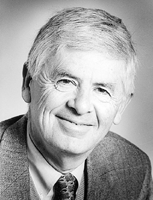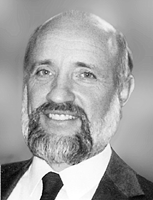Hard Work and Good Mathematics
March 15, 2000

Alexandre Chorin of the University of California, Berkeley, is the co-recipient (with Arthur Winfree of the University of Arizona) of this year's Norbert Wiener Prize. Awarded jointly by the American Mathematical Society and SIAM every five years, the Wiener prize recognizes contributions to applied mathematics, "in the highest and broadest sense."
From the SIAM President
Gilbert Strang
For applied mathematics, the beginning of this year brought important news-and at first sight it all seems to come from Washington. President Clinton has proposed a substantial increase in the National Science Foundation budget. Within NSF, there is exceptionally strong support for mathematics. And in January, at the joint AMS-MAA-SIAM meetings, two distinguished applied mathematicians shared the Norbert Wiener Prize. Before writing any further, I want to say something obvious but important: The NSF increase and the Wiener prizes are direct consequences of hard work and good mathematics that is being done worldwide. Without the efforts of very many people (in teaching as well as research, and in algorithms as well as analysis), applied mathematics would not have achieved this strength and growth.
The proposal by the President is for a 17% increase in the National Science Foundation budget for fiscal year 2001. He is recommending that core programs receive half the increase, which is exceptional. The other half will go to special initiatives, particularly in nanotechnology, biocomplexity, and information technology. Such an increase is made possible by the growth of the economy. But there remains another essential step in the process (and also in the reasoning) because it is Congress that enacts the budget. We hope that members of Congress will see that this economic growth (present and future) would never have happened without the developments in science and engineering.
Within NSF, Rita Colwell and Bob Eisenstein (the NSF director and assistant director for mathematical and physical sciences) have given tremendous personal support to a 22.5% increase for the mathematical sciences. To set priorities and directions, they have invited suggestions from the scientific societies. I will report to you about these discussions. Could I ask for your thoughts specifically about the outstanding opportunities for research in applied mathematics?
The winners of the Wiener prize are Alexandre Chorin from UC Berkeley and Arthur Winfree from the University of Arizona. By a neat chance, both had direct contact with Wiener's ideas in their own work. The connection for Chorin was in statistical mechanics; he found a quick and accurate way to compute Wiener integrals. This was on the way to a deep study of turbulence, where he overcame the blow-up of finite difference errors and simulated the intense dissipation from interacting vortices. The Chorin-Barenblatt improvement to the "law of the wall" in turbulent flow gives spectacular agreement with experiment.
In computational fluid dynamics, two of Chorin's most famous ideas are expressed in the projection method and the vortex method. These algorithms have had a huge impact on combustion calculations and CFD. The goal is to solve the real problems that always arise on scales where ordinary computations will fail! The answer to under-resolved computations can be bigger computers, or it can be better ideas. Chorin has demonstrated (as he has again in his recent work on optimal prediction) that good ideas can win.
Arthur Winfree is the joint recipient of the Wiener prize, and more than that he is one of the great mathematical biologists of our time. He studies oscillations in biological systems. His early work was about synchronization of oscillators (inspired by brain waves, fireflies, and heart pacemaker cells, often numbering in the thousands). The key approximation was to neglect amplitudes and study phases. When the variation in natural frequencies drops below a certain threshold, the system spontaneously organizes itself. Winfree opened the door to a new form of phase transition-not from physics but from dynamical systems and biology.

Honored in January at the AMS-MAA-SIAM meetings, Arthur Winfree shared the 2000 Norbert Wiener Prize with Alexandre Chorin. Coincidentally, SIAM president Gilbert Strang points out, both Winfree and Chorin touched on the work of Wiener in their research.
Winfree also looked at the other side of the problem: Can an oscillation be stopped? Can we drive a biological clock to a "North Pole" where phases converge and amplitudes vanish? Here he showed, first by topology and then by experiment, that the right (mild) stimulus could do it. This totally unexpected conclusion was the beginning of his work on phase singularities. It has led to the discovery of spiral waves---considered impossible by Wiener and Rosenblueth but now recognized in arrhythmias of the heart. I hope that Winfree will forgive this brief summary of his amazing work: He discovered oscillatory patterns that no one expected (they can be life-giving or life-destroying) and he also found out how to stop them. The fundamental tool was the mathematics of phase singularities.
This mention of patterns recalls an outstanding lecture by Alan Newell, also given at the January meetings in Washington. And George Papanicolaou followed with a beautiful exposition of his stochastic model that improves the Black-Scholes equation in mathematical finance. I hope SIAM News will tell you more about those lectures and the success of this joint meeting.
SIAM has its own directions and priorities in mathematics. In the decisions that have to be made in response to an impetus as large as Clinton's, the discussions can be intense. We try to express our thoughts clearly, because SIAM's input is needed. It is a good thing for all of mathematics when the key societies work (and meet) together.

